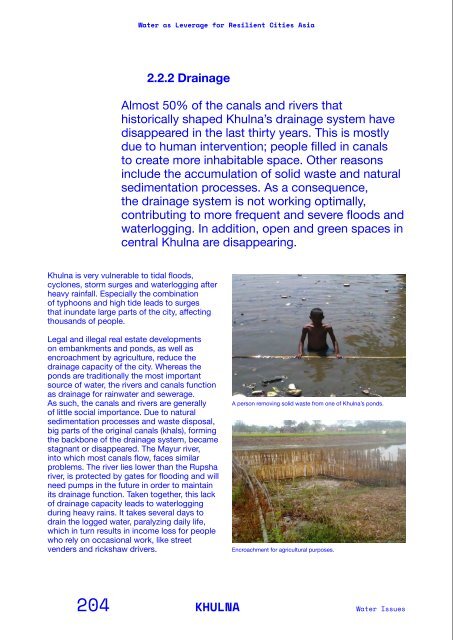Water as Leverage- Setting the scene for a call for action
- No tags were found...
Create successful ePaper yourself
Turn your PDF publications into a flip-book with our unique Google optimized e-Paper software.
<strong>Water</strong> <strong>as</strong> <strong>Leverage</strong> <strong>for</strong> Resilient Cities Asia <strong>Setting</strong> <strong>the</strong> Scene <strong>for</strong> a Call <strong>for</strong> Action Content<br />
2.2.2 Drainage<br />
Almost 50% of <strong>the</strong> canals and rivers that<br />
histori<strong>call</strong>y shaped Khulna’s drainage system have<br />
disappeared in <strong>the</strong> l<strong>as</strong>t thirty years. This is mostly<br />
due to human intervention; people filled in canals<br />
to create more inhabitable space. O<strong>the</strong>r re<strong>as</strong>ons<br />
include <strong>the</strong> accumulation of solid w<strong>as</strong>te and natural<br />
sedimentation processes. As a consequence,<br />
<strong>the</strong> drainage system is not working optimally,<br />
contributing to more frequent and severe floods and<br />
waterlogging. In addition, open and green spaces in<br />
central Khulna are disappearing.<br />
Khulna is very vulnerable to tidal floods,<br />
cyclones, storm surges and waterlogging after<br />
heavy rainfall. Especially <strong>the</strong> combination<br />
of typhoons and high tide leads to surges<br />
that inundate large parts of <strong>the</strong> city, affecting<br />
thousands of people.<br />
Legal and illegal real estate developments<br />
on embankments and ponds, <strong>as</strong> well <strong>as</strong><br />
encroachment by agriculture, reduce <strong>the</strong><br />
drainage capacity of <strong>the</strong> city. Where<strong>as</strong> <strong>the</strong><br />
ponds are traditionally <strong>the</strong> most important<br />
source of water, <strong>the</strong> rivers and canals function<br />
<strong>as</strong> drainage <strong>for</strong> rainwater and sewerage.<br />
As such, <strong>the</strong> canals and rivers are generally<br />
of little social importance. Due to natural<br />
sedimentation processes and w<strong>as</strong>te disposal,<br />
big parts of <strong>the</strong> original canals (khals), <strong>for</strong>ming<br />
<strong>the</strong> backbone of <strong>the</strong> drainage system, became<br />
stagnant or disappeared. The Mayur river,<br />
into which most canals flow, faces similar<br />
problems. The river lies lower than <strong>the</strong> Rupsha<br />
river, is protected by gates <strong>for</strong> flooding and will<br />
need pumps in <strong>the</strong> future in order to maintain<br />
its drainage function. Taken toge<strong>the</strong>r, this lack<br />
of drainage capacity leads to waterlogging<br />
during heavy rains. It takes several days to<br />
drain <strong>the</strong> logged water, paralyzing daily life,<br />
which in turn results in income loss <strong>for</strong> people<br />
who rely on occ<strong>as</strong>ional work, like street<br />
venders and rickshaw drivers.<br />
A person removing solid w<strong>as</strong>te from one of Khulna’s ponds.<br />
Encroachment <strong>for</strong> agricultural purposes.<br />
Toge<strong>the</strong>r with accumulation of solid w<strong>as</strong>te<br />
and sedimentation processes, this h<strong>as</strong> led<br />
to impairments of Khulna’s drainage system,<br />
resulting in more frequent and more severe<br />
floods. In turn, <strong>the</strong>se floods might impede<br />
mobility, <strong>as</strong> infr<strong>as</strong>tructure becomes unusable or<br />
damaged, and might contribute to <strong>the</strong> spread<br />
of waterborne dise<strong>as</strong>es such <strong>as</strong> diarrhea,<br />
dengue, ringworm and dysentery. A lack<br />
of sewerage <strong>as</strong> well <strong>as</strong> proper solid w<strong>as</strong>te<br />
management results in <strong>the</strong> distribution of<br />
large amounts of pollution and w<strong>as</strong>te through<br />
<strong>the</strong> city during floods. The lack of w<strong>as</strong>te<br />
management itself also incre<strong>as</strong>es <strong>the</strong> drainage<br />
problems. Many drains and drainage canals are<br />
blocked by solid w<strong>as</strong>te.<br />
Khulna h<strong>as</strong> a population of 1.9 million, which<br />
produces about 450 tons of solid w<strong>as</strong>te each<br />
day. Given that <strong>the</strong> population is growing<br />
rapidly, enhancing <strong>the</strong> w<strong>as</strong>te management<br />
system is an important challenge <strong>for</strong> <strong>the</strong><br />
future. At this point, about 42% of this w<strong>as</strong>te is<br />
collected and transferred by truck to a landfill<br />
close by Rajbandh, about ten kilometers away<br />
from Khulna. Fur<strong>the</strong>rmore, w<strong>as</strong>te management<br />
is currently still handled by too few people<br />
and with inadequate resources (i.e. small<br />
trucks and small garbage bins). The w<strong>as</strong>te<br />
Siltation of a creek.<br />
that remains uncollected tends to end up in<br />
<strong>the</strong> open spaces throughout <strong>the</strong> city, <strong>the</strong>reby<br />
possibly contributing to issues of waterlogging<br />
and contamination of <strong>the</strong> air and water. A<br />
wide range of NGOs have shown interest in<br />
improving <strong>the</strong> w<strong>as</strong>te processing system of<br />
Khulna. Recent interests focused on fur<strong>the</strong>r<br />
improving <strong>the</strong> community w<strong>as</strong>te management<br />
programs and using <strong>the</strong> w<strong>as</strong>te collected at <strong>the</strong><br />
landfill <strong>as</strong> a resource (Ahsan & Shams, 2009).<br />
Encroachment<br />
by Agriculture<br />
Landfill<br />
Encroachment and<br />
siltation of a creek.<br />
Encroachment by<br />
housing development<br />
Algae bloom<br />
Tidal Sedimentation<br />
204 KHULNA<br />
<strong>Water</strong> Issues<br />
PART 2/Background In<strong>for</strong>mation on <strong>the</strong> Partner Cities<br />
205


















